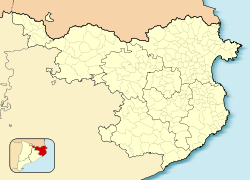Puigcerda
| Puigcerdà | |||
|---|---|---|---|
| Municipality | |||

Casa de la Vila, the city hall
|
|||
|
|||
| Location in Catalonia | |||
| Coordinates: 42°25′54″N 1°55′42″E / 42.43167°N 1.92833°E | |||
| Country |
|
||
| Autonomous community |
|
||
| Province | Girona | ||
| Comarca | Baixa Cerdanya | ||
| Government | |||
| • Mayor | Albert Piñeira Brosel (2015) | ||
| Area | |||
| • Total | 18.9 km2 (7.3 sq mi) | ||
| Elevation | 1,202 m (3,944 ft) | ||
| Population (2014) | |||
| • Total | 8,761 | ||
| • Density | 460/km2 (1,200/sq mi) | ||
| Demonym(s) | Puigcerdanenc | ||
| Time zone | CET (UTC+1) | ||
| • Summer (DST) | CEST (UTC+2) | ||
| Website | puigcerda |
||
Puigcerdà (Catalan pronunciation: [ˌputʃsərˈða], informally: [ˌputʃərˈða], locally: [ˌpʰujsə̃rˈða]) is the capital of the Catalan comarca of Cerdanya, in the province of Girona, Catalonia, northern Spain, near the river Segre and on the border with France (it abuts directly onto the French town of Bourg-Madame).
Puigcerdà is located near the site of a Ceretani settlement, which was incorporated into Roman territory. The Roman town was named Julia Libyca.
Puigcerdà was founded in 1178 by King Alfonso I of Aragon, Count of Barcelona. In 1178 Puigcerdà replaced Hix as the capital of Cerdanya. Hix is now a village in the commune of Bourg-Madame, in the French part of Cerdagne.
Puigcerdà was unique during the Spanish Civil War in having a democratically elected Anarchist council.
The Portet-Saint-Simon–Puigcerdà railway was opened in 1929, crossing the Pyrenees to France.
...
Wikipedia




